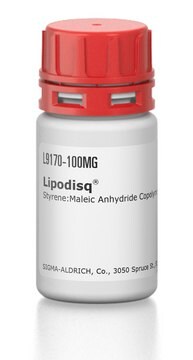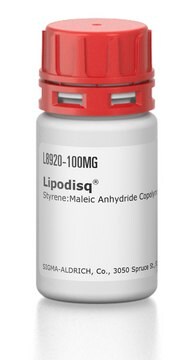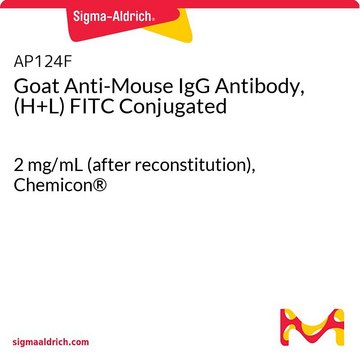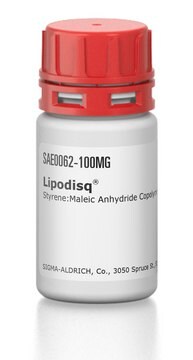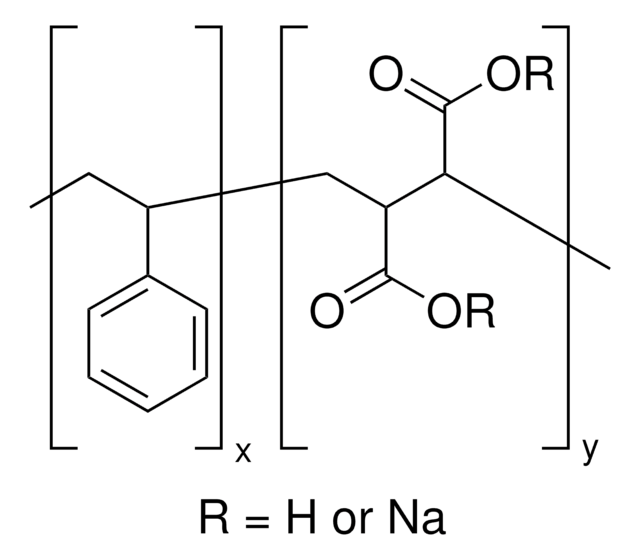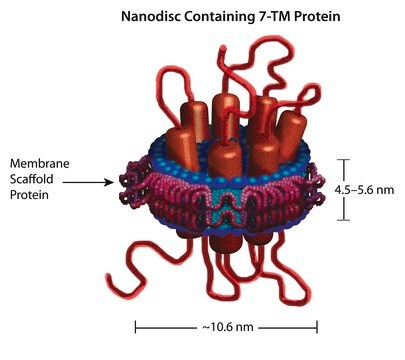L9045
Lipodisq®
Styrene:Maleic Anhydride Copolymer 3:1
Sign Into View Organizational & Contract Pricing
All Photos(1)
About This Item
UNSPSC Code:
12352202
NACRES:
NA.26
Recommended Products
Looking for similar products? Visit Product Comparison Guide
General description
Lipodisq® reagents are novel polymers derived from styrene and maleic acid. Lipodisq® polymers are capable of forming nanosized lipid-based discoidal particles capable of incorporating membrane proteins. Lipodisqs typically have a diameter of 9-10 nm at pH 7.4.
Application
Lipodisq® reagents are novel polymers derived from styrene and maleic acid. Lipodisq polymers are capable of forming nanosized lipid-based discoidal particles capable of incorporating membrane proteins. The Lipodisq technology can solubilize commonly used lipids such as dimyristoylphosphatidylcholine (DMPC) without the use of detergents. In general, Lipodisq polymers are potentially useful in mitigating the use of detergents for the solubilization of membrane proteins. Lipodisqs typically have a diameter of 9-10 nm at pH 7.4.
The Lipodisq technology can solubilize commonly used lipids such as dimyristoylphosphatidylcholine (DMPC) without the use of detergents.
Functional pH range: 6.0 - 9.0
Functional pH range: 6.0 - 9.0
Biochem/physiol Actions
Lipodisq® polymers are potentially useful in mitigating the use of detergents for solubilization of membrane proteins. Dissolving this product in an aqueous solution, with sufficient base (e.g. KOH, NaOH), causes hydrolysis of each anhydride moiety into two carboxylic acid/carboxylate groups. This action renders the SMA polymer soluble in aqueous media. Lipodisq® acts as a potential membrane mimic system.
Legal Information
Lipodisq is a registered trademark of Malvern Cosmeceutics Limited
related product
Product No.
Description
Pricing
Storage Class Code
11 - Combustible Solids
WGK
WGK 3
Flash Point(F)
Not applicable
Flash Point(C)
Not applicable
Choose from one of the most recent versions:
Already Own This Product?
Find documentation for the products that you have recently purchased in the Document Library.
Customers Also Viewed
Indra D Sahu et al.
Biochemistry, 52(35), 5967-5984 (2013-08-22)
Electron paramagnetic resonance (EPR) spectroscopy is a very powerful biophysical tool that can provide valuable structural and dynamic information about a wide variety of biological systems. The intent of this review is to provide a general overview for biochemists and
Juan F Bada Juarez et al.
Chemistry and physics of lipids, 222, 51-58 (2019-05-19)
Lipodisq™ nanoparticles have been used to extract surface lipids from the cuticle of two strains (wild type, N2 and the bacteria-resistant strain, agmo-1) of the C. elegans nematode without loss of viability. The extracted lipids were characterized by thin layer
Juan Francisco Bada Juarez et al.
Biochimica et biophysica acta. Biomembranes, 1862(3), 183152-183152 (2019-12-18)
Dopamine receptors (DRs) are class A G-Protein Coupled Receptors (GPCRs) prevalent in the central nervous system (CNS). These receptors mediate physiological functions ranging from voluntary movement and reward recognition to hormonal regulation and hypertension. Drugs targeting dopaminergic neurotransmission have been
Maria Lyngaas Torgersen et al.
Journal of biomedical nanotechnology, 16(4), 419-431 (2020-09-25)
Many promising pharmaceutically active compounds have low solubility in aqueous environments and their encapsulation into efficient drug delivery vehicles is crucial to increase their bioavailability. Lipodisq nanoparticles are approximately 10 nm in diameter and consist of a circular phospholipid bilayer
Juan Francisco Bada Juarez et al.
Chemistry and physics of lipids, 221, 167-175 (2019-04-04)
Nanoparticles assembled with poly(styrene-maleic acid) copolymers, identified in the literature as Lipodisq, SMALPs or Native Nanodisc, are routinely used as membrane mimetics to stabilise protein structures in their native conformation. To date, transmembrane proteins of varying complexity (up to 8
Our team of scientists has experience in all areas of research including Life Science, Material Science, Chemical Synthesis, Chromatography, Analytical and many others.
Contact Technical Service
